Myles Horton: The Radical Hillbilly
By UAW Region 8 Webmaster John Davis
(Due to the length of this piece, you may choose a shortened version by clicking here, but the story of Myles Horton is worth the time)
History has a habit of recording the feats of the warmongers, the capitalist and the socially elite. However, unfortunately those who strive for the betterment of others seldom are chronicled in the pages of history. One such individual who dedicated his life in service to others was Myles Horton.
Myles Horton was a pioneer in the cause of social justice within the Southern Region of America. He founded the Highlander Folk School in 1932 in Monteagle, Tennessee, about 55 miles northwest of Chattanooga. The school was dedicated to teaching blacks and whites to challenge entrenched social, 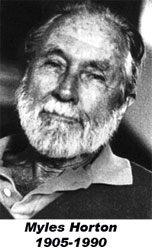 economic and political strictures of a segregated society. Because of his stand on social justice, Horton came under attack by the rich and powerful. economic and political strictures of a segregated society. Because of his stand on social justice, Horton came under attack by the rich and powerful.
In The Beginning
Born in 1905 in Savannah, Tennessee, Myles Horton was raised in a home that knew the struggles of poor working people. The grandson of an illiterate mountain man, his parents were both schoolteachers and devoted to God and community. His Mother’s motto of “God is love and therefore you love your neighbors” was deeply instilled in young Myles.
In 1924 he entered Cumberland College in Tennessee and began his study of education. While working on his college degree, Horton landed a summer job teaching Bible classes to the poor mountain people in nearby Ozone, Tennessee for the Presbyterian Church. It was this experience that convinced the young man to dedicate his life to the struggle for social justice in a world that was organized against the poor. While the Bible lessons were important, he felt the Church was not meeting all the needs of the native people so he developed a desire to place the lessons of the Bible into practice by making a difference. Again and again he witnessed individuals who had sold their land or logging rights to big companies at a fraction of their value. The folk people were then left without land or jobs and ended up working for these companies that had taken advantage of them for menial wages. His own religious convictions propelled him to find a way to be an advocate for these people.
Upon completion of his degree from Cumberland College, he entered the Union Theological Seminary in Manhattan where he was influenced by the teachings of Reinhold Niebuhr, a Christian teacher who was a staunch advocate for the rights of the poor. Myles Horton found in Niebuhr a soul whose convictions for others fueled his own desire to work for others. As his studies at Union continued, Horton developed an idea for a school that would teach the crafts and wisdom of the Appalachian People while empowering them to stand against the greed and tyranny of the corporate establishment that was taking advantage of the people.
At a folk dance he met two Danish-born ministers and told them of his plans to open a “Southern Mountain School” to capture and teach the traditions and worth of the mountain people. They told him about the Danish Folk schools which were based on the same principals. Myles Horton began reading everything he could find on these schools and in 1931 he traveled to Demark to view them first hand. On Horton’s last night in Denmark, December 25, 1931, he wrote: “I can’t sleep, but there are dreams. What you must do is go back, get a simple place, move in and you are there. The situation is there. You start with this and let it grow. You know your goal. It will build its own structure and take its own form. You can go to school all your life, you’ll never figure it out because you are trying to get an answer that can only come from the people in the life situation.”
The Highlander Folk School
In 1932 at the age of 27, Myles Horton returned to Tennessee and opened the Highlander Folk School in Monteagle, about 55 miles northwest of Chattanooga. From the onset the school taught the importance of communication, including, folk songs, story telling and drama. The poor working people of the hill country had proud traditions and the school helped capture their history and traditions while emphasizing leadership and speaking out on behalf of the working poor. The Danish Folk Schools were supported heavily by the trade unions of Europe, so the lessons Horton learned helped solidify his 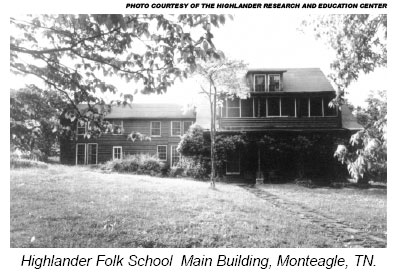 union convictions. However, the Danish folk schools were not his first exposure to organized labor. While still in high school, he worked in a tomato packing plant and helped stage a strike and negotiated better wages for the workers. union convictions. However, the Danish folk schools were not his first exposure to organized labor. While still in high school, he worked in a tomato packing plant and helped stage a strike and negotiated better wages for the workers.
In the post depression years of the 1930s, the poor were taken advantage of especially in the mining and textile industries of the southeast. The design of educational programs at the Highlander School promoted the idea of an exchange of information as opposed to the traditional teacher – student relationship. This allowed everyone – including the teacher to learn from the classes.
The Wilder Strike
The opening of the Highlander School in 1932 coincided with a strike at the coal mines located along the Cumberland Plateau, a chain of mountains through middle and eastern Tennessee. The coming of the Industrial Revolution had stroked the nation’s need for an energy source and coal was that source. The Appalachian Mountain chain was infrastructure, cities and railroads. The answer to this problem ended up being the concept of “Company Towns”, where the coal companies would build a city dedicated to mining coal. The company owned the school, the homes, the churches and the stores. The coal company agents went traveling through the mountain chains purchasing land or mineral rights for very little money. Without their land, the residents found themselves forced to work in the mines on land their families had once owned. Being caught up in the concept of the “company town”, the workers lived in the coal companies house, bought their supplies at the company store, got their mail at the company post office, sent their children to the company school and worshipped at the company church. Of course none of these services were provided for free, with the company deducting the expense from the workers pay. For all practical purposes the workers ended up indentured servants on the same land that had been in their families for generations.
Wilder was a company town about 100 miles from the Highlander School. The depression hit the coal companies hard, with the reduction of building and manufacturing and the reduced demand for coal. The workers at Wilder did not have a union until 1931, as each was forced to sign a “yellow-dog” contract vowing to never join a union. However, the economic crush of the depression forced the companies to scale back on coal production and more and more workers found themselves in a situation of not earning enough to cover what they owed the company to live in their house, let along having enough left over to buy food at the company store. The workers decided to form a union in hopes of winning better wages to feed their starving families. In the area there were three coal companies who competed against each other. The companies made a pack to stick together to keep the union out, by shutting the mines down until the workers agreed to return without a union. One of the companies double crossed the other two by staying open, so the remaining companies reopened recognizing the union and offering a contract that had no pay increases, but a promise not to cut wages.
The company reneged on the contract and offered a new one that included 20% wage cuts and forced the workers to void the union. On July 9, 1932 the union struck the mines and a year long struggle would begin for the workers at Wilder. The companies brought in scabs from surrounding areas to work the mines and began a series of terror tactics against the striking workers.
Mean while down in Monteagle, Myles Horton learned of the struggles of the striking miners in Wilder. He traveled the 100 miles in late November to see for himself what was going on. He found the coal companies had shut off the electricity to the company houses and had the doors removed even though it was a bitterly cold winter. The Red Cross had sent food to the strikers, but the local Red Cross Chapter was ran by the wife of a superintendent at the mine so the food was distributed to the scabs instead of the strikers
Myles Horton stayed in the home of the Miners Union President Jim Crownover and could not believe what he was seeing. Horton would write “We found the people drawn and pale from malnourishment, although their resolve was strong and unshaken. They were held together by their common misery. The town was divided, the scabs living in the camp houses on one side, the strikers on the other. There was a "dead line" and one crossed it at his peril. On the strikers' side, the water and electricity were cut off. It was my first inkling that folk could starve to death in the United States of America in plain view of a largely indifferent populace.”
Myles Horton enlisted the help of the students and teachers at the Highlander School to aide the striking workers. Food and clothing donations began pouring in from around the state, as Horton began writing letters and sending editorials to papers around the south telling of the plight of the people in Wilder. As the strike worn into the winter, violence erupted between the strikers and the scabs, which were aided by the company. The National Guard was sent in to “protect” the company assets, when in fact the strikers had to meet in the dark to prevent speakers from being shot by snipers the company hired.
On one of his trips to Wilder, Myles Horton was arrested by a National Guard officer and charged with “getting information and carrying it back and teaching it.” The charges were eventually dropped, but this would be the first of many arrests for Myles Horton. He continued to write to newspapers about the violence and outlandish treatment the coal companies issued. Union official Barbey Graham was murdered by two gunmen brought in by the coal companies. The killers were brought to trial, but acquitted on the grounds of self-defense. This was absurd, because Graham had been shot ten times and his head busted open. The violence intensified after the murder of Graham and the strikers were evicted from their homes. Myles Horton went to the chief of TVA and persuaded him to hire many of the strikers on the Norris Dam project while others found work in President Roosevelt’s WPA and CCC projects.
Aligning The Highlander Folk School For Activism
From the experience Myles Horton learned the importance of teaching union leaders bargaining and union business. These topics became integrated in the curriculum at Highlander as the schools purpose turned more toward collective bargaining and social activism.
The Wilder strike brought a lot of publicity to the Highlander School, but it wasn’t all positive. The wealthy and powerful feared the school could become involved in issues that could affect them, so a smear campaign was started to paint Myles Horton as a communist. This was an accusation that Horton would be forced to deny again and again. The powers that be tried every dirty trick in the book to discredit the work the Highlander School was doing, for it was the education and purpose the school provided to its students the wealthy feared the most. By separating people by race, by gender, by 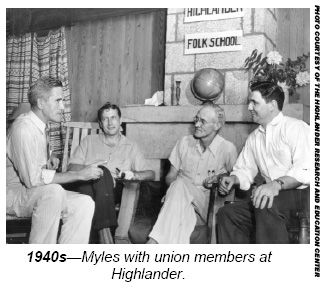 nationality or by religion, the effectiveness of their solidarity is compromised. Horton realized this and sought ways to avoid these battles with the teachings of the Highlander School. He came away from the Wilder incident with a determination to make a difference and knew the key was education and began building a curriculum that would provide working class people with the tools they needed to stand and fight. nationality or by religion, the effectiveness of their solidarity is compromised. Horton realized this and sought ways to avoid these battles with the teachings of the Highlander School. He came away from the Wilder incident with a determination to make a difference and knew the key was education and began building a curriculum that would provide working class people with the tools they needed to stand and fight.
In 1937 he joined the staff of what was then called the Committee for Industrial Organization (CIO) and organized one of the first CIO locals in the southern textile industry. Horton tried to form a coalition of farm workers, but found race to be a barrier in bringing the workers together. It became apparent that to bring workers together he would have to find ways to remove the barriers that separated them. Miles Horton then turned his attention toward developing civil rights classes for both blacks and whites to break down the racial barrier that separated working people.
Highlander Folk School and Civil Rights
In 1934 the first black speaker presented a workshop at Highlander, but the workshops weren’t full integrated until 1942. While Highlander was known for progressive thinking, this was still the South and such things weren’t done. In 1944 the leaders of UAW locals attended a fully integrated workshop, defying the local customs and the customs of much of organized labor. The Highlander staff was fully convinced that success in the labor movement would require addressing the issue of racism and breaking down the bounds of segregation. It was during this time that opponents of the school began comparing the teachings with communism and began working to silence Myles Horton and the Highlander Folk School.
By 1953 the Highlander Folk School found itself in a transition from concentrating primarily on labor 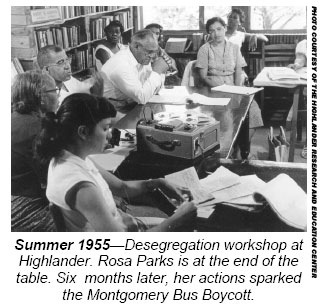 education to shifting more emphasis on teaching the principles of civil rights. Myles Horton and his staff believed that solidarity between the region’s workers was the key to winning the battle over poverty and oppression of workers. In addition, the Supreme Court was gearing up to tackle the Brown Verses the Board of Education Case, which would have a dramatic impact on the South regardless of the outcome. education to shifting more emphasis on teaching the principles of civil rights. Myles Horton and his staff believed that solidarity between the region’s workers was the key to winning the battle over poverty and oppression of workers. In addition, the Supreme Court was gearing up to tackle the Brown Verses the Board of Education Case, which would have a dramatic impact on the South regardless of the outcome.
The school decided to focus their attention on school desegregation, voter education and voter’s rights. As Highlander began offering workshops on these subjects, more and more of the Civil Rights Movement Leaders began to attend the sessions. It was at these sessions that Highlander integrated their long standing policy of using story telling and singing to aide in the education and songs such as “We Shall Overcome” and “Keep Your Eyes on the Prize” were taught to the participants who carried them back to the work in their home areas.
Highlander helped launch the “Citizen Ship Schools” across the South, whose purpose was to teach African-Americans to read so they could pass the literacy test required for voting rights in much of the South. These schools would provide the basis for the organized Civil Rights Movement across the South.
Rosa Parks
In 1955 a young African-American lady by the name of Rosa Parks attended a desegregation workshop being held at the Highlander Folk School. Mrs. Parks had been working with the NAACP in Montgomery, Alabama to assist with voter registration for minorities. Later she would make the statement that she left Highlander uncertain as to if the people in Montgomery would stick together to fight segregation. She went on to say that her time at Highlander was the first time she “lived in an atmosphere or equality with members of the other race.”
However, she returned to the Highlander School a year later and 100 days into a bus boycott that would eventually last 381 days as 50,000 people of Montgomery did stick together. During that visit she and Myles Horton discussed at great length the hardships and struggle the bus boycott required on those 50,000 who were walking everyday, but the victory in the end proved to be worth the sacrifice. Rosa Parks last visited the Highlander School in 1990 to attend the memorial for Myles Horton following his death.
No Good Deed Goes Unpunished
On the 25th anniversary of the Highland Workshops in 1957, Dr. Martin Luther King, Jr. was the featured speaker. The growing Civil Rights Movement made the segregationist nervous in the South and they placed the bulk of the blame at the feet of the Highlander Folk School. The Georgia Commission on Education published a slanderous piece of propaganda called Highlander Folk School: Communist Training School, Monteagle, Tennessee. Billboards and newspapers carried photos of a black man dancing with a white woman at the Highlander School, fueling public sentiment against the workshops.
Even though dignitaries such as Eleanor Roosevelt and United Nations Under-Secretary Ralph Bunche lauded the accomplishments of the school, the Tennessee Supreme Court set about to shut the school down.
In 1957 Mississippi Senator James Eastland was serving as chairman of the Senate Internal Security subcommittee and launched and investigation on the Highlander Folk School alleging communist ties. Myles Horton repeatedly denied that neither he nor the Highlander School had any link to communism. While on the stand during the Supreme Court hearing Myles Horton was asked to acknowledge the accusations of his politics but refused, but did not plead the Fifth Amendment. He testified for four 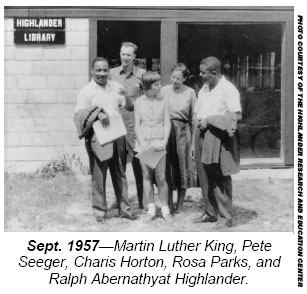 hours, defending the school and his own reputation against the claims of communist ties. While no evidence was found linking Highlander with any subversive group, Tennessee Attorney General Albert Sloan filed a suit to have the schools charter revoked based on allegations the school was conducting integrated studies which was against Tennessee State law. hours, defending the school and his own reputation against the claims of communist ties. While no evidence was found linking Highlander with any subversive group, Tennessee Attorney General Albert Sloan filed a suit to have the schools charter revoked based on allegations the school was conducting integrated studies which was against Tennessee State law.
On July 31, 1959 Sloan lead a group of twenty sheriffs deputies to the school and arrested a biracial group attending the Highlander Citizenship School on the grounds of integration. Sloan bragged to the Chattanooga Daily Times “the members of the legislative committee gave me information mostly on integration and communism, and I wasn’t satisfied I could be satisfied at that. I thought maybe this was the best shot and I think now I’ll be successful.” Sloan finally got an injunction against the school and padlocked the doors temporarily. In the fall of 1959 Myles Horton temporarily transferred the function of the Citizenship Schools to the Southern Christian Leadership Conference. “You can padlock a building,” Myles Horton stated. “You can’t padlock an idea. Highlander is an idea. You can’t kill it and you cant close it in. This workshop is part of the idea. It will grow wherever people take it.”
The Highlander Research and Education Center is Born
The Tennessee Supreme Court trail ended in February of 1960 with the schools charter being revoked and the buildings padlocked. A few days later many of them mysteriously burned to the ground and the land was sold at public auction with Myles Horton never seeing a cent for his personal property that was attached to the grounds. Undeterred, Horton filed for a new charter and opened the Highlander 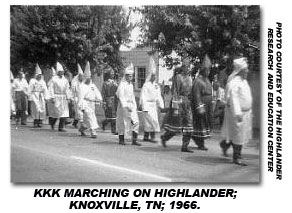 Research and Education Center never Knoxville, Tennessee in 1961. As a footnote to the tragic tale of the Monteagle location, lawyers from the area bought the building that housed the Highlander Library and turned it in to an exclusive club, flaunting segregation in the building that housed so much work for integration. Research and Education Center never Knoxville, Tennessee in 1961. As a footnote to the tragic tale of the Monteagle location, lawyers from the area bought the building that housed the Highlander Library and turned it in to an exclusive club, flaunting segregation in the building that housed so much work for integration.
Just as the mythical Phoenix Bird would consume itself in fire at the end of its life and be reborn among the ashes, the idea that Myles Horton spoke of was reborn from the ashes of the Highlander Folk School as the Highlander Research and Education Center. Myles Horton began to transfer the leadership of the Citizenship Schools to the Southern Christian Leadership Conference and turned his attention toward the struggles of the people of Appalachia.
Appalachian Focus Returns
In 1971 the Highlander Research and Education Center moved from Knoxville to a ridge top farm new New Market, Tennessee. The Appalachian Mountain chain was riddled with poverty, growing environmental concerns and was falling within the grip of corporate control. Working with the Appalachian Alliance, Highlander began a study of land ownership of Appalachia and documented the take over of the mountains by the corporations and the devastation that was dealt upon the land. Strip mining was taking its toll on the natural beauty and function of the land, so Highlander worked diligently to fight this rape of the land, its resources and its people. There were workshops offered, teaching local activist to research and protest the devastation in their own areas. In the 1980s 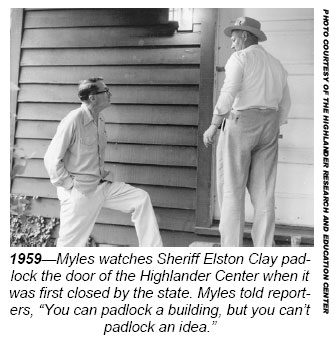 Highlander began to connect to organizers and activist beyond the borders of the United States to assist in educational opportunities for others. Highlander began to connect to organizers and activist beyond the borders of the United States to assist in educational opportunities for others.
At the school’s 50th anniversary in 1982, hundreds of former students returned to the school to honor the man whose vision made it all possible. The event was covered in a major documentary called You Gotta Move.
In 1982, both Myles Horton and Highlander were nominated for a Nobel Peace Prize for its historic role in providing education on behalf of human rights in the region. Time magazine called Highlander “one of the South’s most influential institutions of social change in 1990. That was the same year there were two books released by Myles Horton including The Long Haul: an Autobiography and We Make the Road by Walking: Conversations on Education and Social Change. However, Horton did not get to see his books in print for he died on January 19, 1990. That same year The Long Haul won the Robert F. Kennedy Book Award.
In 84 years Myles Horton along with his wife Zilphia Mae Johnson Horton (who died in 1955) dedicated a life of service to others. This dedication did not come without struggles or attacks, but Myles Horton always keep his eye of the goal. In The Long Haul, Myles Horton made this statement about the vision and idea of Highlander.
“To get something like this going in the first place you have to have a goal. That goal shouldn't be one 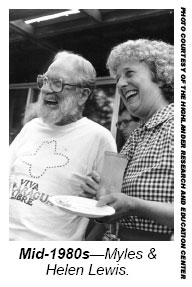 that inhibits the people you're working with, but it should be beyond the goal you expect them to strive for. If your goal isn't way out there somewhere and isn't challenging and daring enough, then it is going to get in your way and it will also stand in the way of other people. Since my goal happened to be a goal of having a revolutionary change in this country and all over the world, its unlikely to get in the way in the near future.” that inhibits the people you're working with, but it should be beyond the goal you expect them to strive for. If your goal isn't way out there somewhere and isn't challenging and daring enough, then it is going to get in your way and it will also stand in the way of other people. Since my goal happened to be a goal of having a revolutionary change in this country and all over the world, its unlikely to get in the way in the near future.”
Myles Horton shaped the past and his vision is still shaping the present and future. Today the Highlander Research and Education Center continues the dream and work of a great man. He was described himself as a “radical hillbilly” but this tongue in cheek characterization in no way does justice to a man whose work and vision set the standard for generations to follow.
|